Gamifying Sociological Surveys Through Serious Games—A Data Analysis Approach Applied to Multiple-Choice Question Responses Datasets
Abstract
1. Introduction
- Functional Tasks Integration (Platform Layer):
- Process Coordination (Engine Layer):
- Endpoint Provision (Game Layer):
- Separation of Concerns (Application Layer):
2. Related Works
2.1. Brief Literature Review
2.2. Questions Presented During Gameplay
- Democratic Radicalism: Seeks societal transformation through democratic means.
- Critical Liberalism: Emphasizes social justice and critiques traditional liberal thought.
- Depoliticization: Removes issues from the public sphere; exclusive to experts or elites.
- Conservatism: Emphasizes tradition, order, and stability.
- Authoritarianism: Strict control suppresses dissent in government.
- Nihilism: Rejects accepted aspects of human existence (knowledge, morality, etc.) represented by the Greek slang word “kava”.
- Realism: Emphasizes power, national interest, and balance of power in international politics.
- Technocracy: Advocates rule by experts, particularly scientists and engineers.
- Cultural Reductionism: Believes cultural differences can be explained by a single factor, like race, ethnicity, or religion.
- Humanism: Emphasizes human reason, freedom, and dignity in philosophy and ethics.
- Meritocracy: Rewards based on ability and effort, not social class or background.
- Communalism: A political and economic system based on cooperation, mutual aid, and shared resource ownership.
2.3. Research Questions
- How can modular middleware architectures improve the performance of serious games?
- Existing middleware often introduces computational overhead, affecting rendering and simulations. We address this by decoupling front-end rendering from game logic and by implementing a lightweight scene transition mechanism to enhance performance with minimal memory usage.
- Our research considers how cloud gaming and AI-powered engines may further improve middleware efficiency, proposing a contribution in the form of a modular, lightweight design for better integration.
- In what ways can serious games be optimized to collect behavioral data in real-time without compromising system performance or user privacy?
- Traditional middleware is not tailored for real-time analytics. Our approach integrates real-time event tracking and cloud-based storage using Firebase, ensuring both scalability and minimal performance impact.
- The contribution lies in enabling secure and ethical behavioral data collection while preserving player anonymity.
- How can game middleware be designed for seamless cross-platform compatibility?
- Many middleware systems fail to support efficient deployment across platforms like PC, mobile, WebGL, and VR. We address this by separating front-end and back-end processes, allowing easy adaptation.
- This work contributes a platform-agnostic middleware design, suitable for integration with multiple game engines and deployment environments.
3. Methodology
3.1. Game Resources Used and Challenges
3.1.1. DB Tables
- Create Table Function: This function is designed to create a table with a specific structure to store players’ answers if it does not already exist. It ensures that the database is appropriately configured to store the required information.
- Insert Into Function: The second function involves executing insert commands to add new rows to one of the two tables based on the player’s quests. This function is responsible for populating the database with relevant data corresponding to the player’s actions and choices during gameplay.
3.1.2. Software Specifications (Serious Game Engine Explained)
3.1.3. Technical Challenges and Solutions
3.2. Algorithms and Rationale of E-Polis Digital Game
3.2.1. Scene Transition Mechanism
3.2.2. Initial Algorithm for Scene Transition Using Prefab Collisions
- Core principle:
- ○
- Detects when a player enters a specific area.
- ○
- Presents a dilemma (question) that the player must respond to.
- ○
- Records the player’s choice and adjusts game world variables.
- Purpose of implementation:
- ○
- Used to trigger dilemmas based on player movement to a prefix game world space (road).
- ○
- Ensures game progression only occurs when questions are answered.
- ○
- Enables real-time interaction with the game environment variables.
- How the system works:
- ○
- When a player enters a prefab area, the algorithm activates a pop-up containing a question (dilemma).
- ○
- Player selection updates the game world variables and stores their response for analysis.
- ○
- The dilemma does not disappear when answered; the player is moved outside of the trigger area to see the results of his/her choice and can re-enter and re-answer.
- Pseudocode Presentation:
| def on_player_enter_area(player, prefab_area): if player.position in prefab_area: dilemma = get_dilemma(prefab_area) display_dilemma(dilemma) response = player.respond_to_dilemma() store_response(player.id, dilemma.id, response) update_scene_state(dilemma, response) |
- Core principle:
- ○
- Implements real-time changes to game graphics based on player decisions.
- ○
- Unlike the previous approach, pre-rendered objects are modified dynamically.
- Purpose of implementation:
- ○
- Enhances the visual part of our game by allowing players to construct the city’s layout based on their responses.
- ○
- Avoids the limitations of prefabs by using modular rendering techniques.
- How the system works:
- ○
- Each building starts as a disabled object.
- ○
- If the player selects a response, the algorithm modifies the object properties (e.g., texture, shape).
- ○
- It ensures a persistent world transformation, where choices have consequences for the outcome of the city blueprint and design.
- Pseudocode Presentation:
| def update_scene(player_choice): for object in scene_objects: if is_affected_by_choice(object, player_choice): modify_object_properties(object, player_choice) render_updated_scene() |
3.2.3. Player Decision Processing Algorithm
- Core principle:
- ○
- Collects and logs player responses in a structured format (but as unstructured data).
- ○
- Ensures consistency and integrity in response collection (definitions of wrong execution and try-catch blocks for failures and errors during db communication or server authentication).
- Purpose of implementation:
- ○
- Supports sociological and political research by mapping player choices to categories.
- ○
- Enables researchers to analyze trends and decision patterns.
- How the system works:
- ○
- Each player’s response was initially stored in a structured CSV file and then expanded through this operation and stored in a remote DB repository in Brussels (Firebase).
- ○
- Metadata such as time taken to answer, player position, and scene details are recorded.
- ○
- These data points can later be processed using statistical clustering and machine learning models.
- Pseudocode Presentation:
| def log_player_decision(player_id, dilemma_id, response): timestamp = get_current_time() log_entry = f”{player_id},{dilemma_id},{response},{timestamp}” write_to_RemoteDB(“player_responses.Db”, log_entry) |
3.2.4. Distributed Player State Synchronization Algorithm
- Core principle:
- ○
- Synchronizes game state across multiple players in real-time.
- ○
- Uses Firebase cloud storage to ensure consistency in game state.
- Purpose of implementation:
- ○
- Allows multiple players to influence the same city without inconsistencies.
- ○
- Prevents data loss by storing results remotely.
- How the system works:
- ○
- Player actions and choices are broadcast to Firebase.
- ○
- Other players receive live updates reflecting new game conditions (changes in city structure).
- ○
- Ensures that all participants experience the same urban transformation process.
- Pseudocode Presentation:
| def sync_state_to_cloud(player_id, game_state): firebase.update(f”game_states/{player_id}”, game_state) def retrieve_state_from_cloud(player_id): return firebase.get(f”game_states/{player_id}”) |
3.2.5. Endgame Consensus-Based Voting Algorithm
- Core principle:
- ○
- Aggregates player votes on the final city structure.
- ○
- Uses a weighted ranking system to determine overall satisfaction.
- Purpose of implementation:
- ○
- Allows players to reflect on the collective decisions made during gameplay(single player = 1 player or else multiplayer 2 to 6 players per room).
- ○
- Provides researchers with insights into public preferences regarding urban planning.
- How the system works:
- ○
- Each player submits a final vote (like, dislike, neutral).
- ○
- Votes are aggregated and stored in Firebase.
- ○
- The final consensus rating is not displayed in the endgame summary so as not to affect the players’ decisions and perception of the final structure of the city.
- Pseudocode Presentation:
| def calculate_final_votes(votes): total_votes = len(votes) positive = sum(1 for v in votes if v == “like”) negative = sum(1 for v in votes if v == “dislike”) other = sum(1 for v in votes if v == “other”) consensus_score = [positive,negative,other] return consensus_score |
3.2.6. Game Workflow Algorithm
- Core principle:
- ○
- Ensures player interactions and decisions are stored in real-time.
- ○
- Maintenance of an accurate record of each player’s responses and voting preferences.
- ○
- Game state updates from building structures to scene transition to the final voting view from the above view.
- Purpose of implementation:
- ○
- To log and store players’ responses to dilemmas.
- ○
- To track the game’s progress and maintain session consistency.
- ○
- To preserve final voting results and the evolving city structure for later evaluation and analysis.
- ○
- To ensure data integrity and persistence remote database repository, preventing data loss.
- How the system works:
- ○
- The player submits an answer to an in-game dilemma.
- ○
- The system captures key metadata:
- ▪
- Player ID (Unique identifier).
- ▪
- Dilemma ID (Question being answered).
- ▪
- Selected Answer (Choice made by the player).
- ▪
- Timestamp (When the decision was recorded).
- ▪
- Game Room (The session the player is part of).
- ○
- The system constructs a database entry with this information.
- ○
- The data are stored in Firebase (a cloud-based game).
- ○
- If necessary, the system updates the game state based on the recorded response.
4. Results
4.1. Step 1: Import Python Library Components
- Pandas: Used for data handling and manipulation of data frames (tabular data structures) for ETL (Extract, Transform, Load) operations on the provided .csv files containing questions and quests (Pandas. Pandas Documentation 2025. Available online: https://pandas.pydata.org/ (accessed on 19 May 2025)).
- SQLite3: Employed to define the database library (SQLite) for database interactions. This includes creating tables and performing CRUD (Create, Read, Update, Delete) operations (Python Software Foundation. SQLite3 Documentation. Python Software Foundation 2025. Available online: https://docs.python.org/3/library/sqlite3.html (accessed on 19 May 2025)).
- NumPy: Utilized for mathematical calculations and data analysis, providing functionality for defining and performing operations with arrays and matrices. It plays a crucial role in conducting mathematical operations on our game data (NumPy. 2025. Available online: https://numpy.org/ (accessed on 19 May 2025)).
- Matplotlib: Used to create plots and charts representing players’ answers. Matplotlib is a versatile plotting library that supports a wide range of visualization types (Matplotlib. 2025. Available online: https://matplotlib.org/ (accessed on 19 May 2025)).
- Plotly Express: Similar to Matplotlib, Plotly Express extends our visualization capabilities, offering an extensive set of creative and interactive visualizations, especially for scatter plots. It provides additional features like annotations and legends on figures (Plotly Express. 2025. Available online: https://plotly.com/python/plotly-express/ (accessed on 19 May 2025)).
- Warnings: We employed “warnings.simplefilter(action = ‘ignore’, category = FutureWarning)” to suppress warnings during the execution of the Jupyter Notebook produced by Alexandros Gazis, Agrinio, Greece, Python version 3.6.8, virtualenv 20.13.0, This ensures a smoother execution flow and helps in handling errors and messages more efficiently (Python Software Foundation. Python Warnings. 2025. Available online: https://docs.python.org/3/library/warnings.html (accessed on 19 May 2025)).
- Time: Used to generate timestamps from the local work machine’s execution time. Timestamps are incorporated into the generated output files of our tests, providing a temporal reference for analysis (Python Software Foundation. Python Time. Time command 2025. Available online: https://docs.python.org/3/library/time.html (accessed on 19 May 2025)).
4.2. Step 2: Parse the Csv, Analyze Data, Create Db Tables
- create_table function accepts a data frame, selects specific rows and columns, and uses an existing DataFrame to perform the selection. Subsequently, it employs the iloc method to extract the chosen rows and columns from the original DataFrame, resetting the index of the new DataFrame to start from zero.
- create_table_diag function rearranges data into a diagonal pattern to generate a new DataFrame. While similar to create_table, this function creates a distinct data structure. It assembles a new DataFrame from an existing one by organizing the data diagonally. To achieve this, the function calculates the dimensions of the original DataFrame (N, M), forms a list of column names for the new DataFrame (including original column names and diagonal column names), and populates the table with zero values except for the diagonal entries.
- create_db function takes two DataFrames and stores them in an SQLite database with two tables. Initially, it establishes a connection to the SQLite database. Subsequently, it utilizes the to_sql method to save the two DataFrames to the database.
4.2.1. Example of the Actual Dataset with Player’s Dilemmas
4.2.2. Example of the Actual Dataset with Player’s Dilemmas in a Diagonal Pattern
4.3. Step 3: Analyzing Data and Exporting DB Data
4.4. Step 4: Visualizing Responder’s Data
4.5. Step 5: Validate the Ground Truth of Our Results: PCA Analysis
5. Discussion
5.1. Data Analysis
5.2. Limitations
5.2.1. Game Middleware—Large-Scale Architectural Design
5.2.2. Game Middleware—Adaptive Architectural Design Principles
5.2.3. Game Middleware—Traditional Synchronous Client–Server Communication
5.2.4. IoT and Game Middleware—Security and Service Management in IoT SOA Middleware
- It extends a SOA-based communication layer by treating players and their interactions as (real-time) data streams, similar to sensor networks.
- Instead of traditional client–server connections, it ensures event-driven synchronization between game instances, dynamically managing service requests and state transitions without requiring continuous polling.
- It introduces a smart scene transition mechanism that ensures data are securely transmitted and validated before affecting game state changes, thus preventing unauthorized client manipulations.
6. Conclusions
Author Contributions
Funding
Data Availability Statement
Acknowledgments
Conflicts of Interest
Appendix A
Game Workflow Pseudocode Presentation
| import time import firebase_admin from firebase_admin import credentials, db # Firebase Authentication Setup def initialize_firebase(): “““Initializes Firebase connection using service account credentials. Ensures secure authentication and access to the database. “““ cred = credentials.Certificate(“path/to/serviceAccountKey.json”) firebase_admin.initialize_app(cred, { ‘databaseURL’: ‘https://our-database-name.firebaseio.com/’ }) print(“Firebase initialized successfully.”) # Function to get current timestamp def get_current_timestamp(): “““Returns the current timestamp in a standard format.”““ return time.strftime(‘%Y-%m-%d %H:%M:%S’) # Store player response in Firebase def store_player_answer(player_id, dilemma_id, selected_answer, game_room, auth_token): “““Stores the player’s response securely in Firebase (param player_id: Unique identifier for the player, param dilemma_id: Unique identifier for the dilemma question, param selected_answer: The player’s chosen response, param game_room: The game session the player is part of, param auth_token: Authentication token for verifying user access.”““ timestamp = get_current_timestamp() # Authenticate user session if not authenticate_player(player_id, auth_token): print(f”Authentication failed for Player {player_id}. Data not stored.”) return # Reference to Firebase game room answers ref = db.reference(f’game_rooms/{game_room}/player_answers’) ref.push({ ‘player_id’: player_id, ‘dilemma_id’: dilemma_id, ‘answer’: selected_answer, ‘timestamp’: timestamp }) print(f”Stored response for Player {player_id} in Room {game_room}”) # Firebase Authentication Function def authenticate_player(player_id, auth_token): “““Validates the player’s authentication token before storing data (where, param player_id: Unique identifier for the player, param auth_token: Token issued for verifying player authentication, return: Boolean indicating whether authentication was successful.”““ auth_ref = db.reference(f’authenticated_users/{player_id}’) stored_token = auth_ref.get() if stored_token == auth_token: return True else: return False # Initialize Firebase Connection initialize_firebase() # Example Usage store_player_answer(player_id=12, dilemma_id=5, selected_answer=“Option A”, game_room=2, auth_token=“valid_token_123”) store_player_answer(player_id=15, dilemma_id=7, selected_answer=“Option C”, game_room=3, auth_token=“invalid_token_456”) |
References
- Gazis, A.; Katsiri, E. E-polis: An innovative and fun way to gamify sociological research with an educational serious game—Game development middleware approach. Int. J. Educ. Inf. Technol. 2024, 18, 20–32. [Google Scholar] [CrossRef]
- Park, H.E. Designing engagement: Exploring affordances in freemium digital games. Technol. Soc. 2025, 11, 102840. [Google Scholar] [CrossRef]
- Tene, T.; Vique López, D.F.; Valverde Aguirre, P.E.; Cabezas Oviedo, N.I.; Vacacela Gomez, C.; Bellucci, S. A systematic review of serious games as tools for STEM education. Front. Educ. 2025, 7, 1432982. [Google Scholar] [CrossRef]
- Kouzelis, G. 1st Call for H.F.R.I. Research Projects to Support Faculty. Research Projects to Support Faculty Members and Researchers and Procure High-Value Research Equipment. H.F.R.I. Grant Project 2021. Available online: https://www.elidek.gr/wp-content/uploads/2021/02/Κουζέλης-EN.pdf (accessed on 20 May 2025).
- Haoyu, W.; Haili, Z. Basic design principles in software engineering. In Proceedings of the IEEE Fourth International Conference on Computational and Information Sciences, Chongqing, China, 17–19 August 2012; pp. 1251–1254. [Google Scholar] [CrossRef]
- Alizadeh, A. Design and Implementation of a Web-Based Editor optimized for Online Gambling Games. Master’s Thesis, Aalto University, Espoo, Finland, 2022. Available online: https://aaltodoc.aalto.fi/handle/123456789/112844 (accessed on 20 May 2025).
- Linina, I.; Villerte, K.; Vevere, V.; Zvirgzdina, R. FUser Experience (UX) Design Websites as a Marketing Tool. WSEAS Trans. Bus. Econ. 2024, 21, 1461–1471. [Google Scholar] [CrossRef]
- Tran, C. Applying test-driven development in evaluating student projects. Doria Repos. 2020. Available online: https://www.doria.fi/handle/10024/176543 (accessed on 20 May 2025).
- Filazzola, A.; Lortie, C.J. A call for clean code to effectively communicate science. Methods Ecol. Evol. 2022, 13, 2119–2128. [Google Scholar] [CrossRef]
- Neutens, T.; Coolsaet, K.; Wyffels, F. Assessment of code, which aspects do teachers consider and how are they valued? ACM Trans. Comput. Educ. 2022, 22, 1–27. [Google Scholar] [CrossRef]
- Motlagh, M.; Horcea-Milcu, A.I.; König, B. Discovering the potential of serious games for transformative sustainability research. Discov. Sustain. 2025, 15, 30. [Google Scholar] [CrossRef]
- Shen, Y.; Ab Jalil, H.; Jamaluddin, R. A 10-Year Systematic Review on the Incorporation of Digital Games for Multimodal Literacy Education. WSEAS Trans. Comput. Res. 2024, 12, 463–474. [Google Scholar] [CrossRef]
- Dernat, S.; Grillot, M.; Andreotti, F.; Martel, G. A sustainable game changer? Systematic review of serious games used for agriculture and research agenda. Agric. Syst. 2025, 1, 104178. [Google Scholar] [CrossRef]
- Zhao, D.; Muntean, C.H.; Chis, A.E.; Rozinaj, G.; Muntean, G.M. Game-based learning: Enhancing student experience, knowledge gain, and usability in higher education programming courses. IEEE Trans. Educ. 2022, 10, 502–513. [Google Scholar] [CrossRef]
- Isaeva, R.; Karasartova, N.; Dznunusnalieva, K.; Mirzoeva, K.; Mokliuk, M. Enhancing learning effectiveness through adaptive learning platforms and emerging computer technologies in education. J. Ilm. Ilmu Terap. Univ. Jambi. 2025, 16, 144–160. [Google Scholar] [CrossRef]
- Ding, A.C.; Yu, C.H. Serious game-based learning and learning by making games: Types of game-based pedagogies and student gaming hours impact students’ science learning outcomes. Comput. Educ. 2024, 1, 105075. [Google Scholar] [CrossRef]
- Gaurav, D.; Kaushik, Y.; Supraja, S.; Yadav, M.; Gupta, M.P.; Chaturvedi, M. Empirical study of adaptive serious games in enhancing learning outcome. Int. J. Serious Games 2022, 31, 27–42. [Google Scholar] [CrossRef]
- Triantafyllou, S.A.; Sapounidis, T. Game-based Learning approach and Serious Games to learn while you play. In Proceedings of the IEEE World Engineering Education Conference (EDUNINE), Bogotá, Colombia, 12–15 March 2023; pp. 1–6. [Google Scholar] [CrossRef]
- Furtado, L.S.; de Souza, R.F.; Lima, J.L.; Oliveira, S.R. Teaching method for software measurement process based on gamification or serious games: A systematic review of the literature. Int. J. Comput. Games Technol. 2021, 2021, 8873997. [Google Scholar] [CrossRef]
- Sharif, K.H.; Ameen, S.Y. Game engines evaluation for serious game development in education. In Proceedings of the 2021 International Conference on Software, Telecommunications and Computer Networks (SoftCOM), Vitual, 23–25 September 2021; pp. 1–6. [Google Scholar]
- Politowski, C.; Petrillo, F.; Montandon, J.E.; Valente, M.T.; Guéhéneuc, Y.G. Are game engines software frameworks? A three-perspective study. J. Syst. Softw. 2021, 1, 110846. [Google Scholar] [CrossRef]
- Vohera, C.; Chheda, H.; Chouhan, D.; Desai, A.; Jain, V. Game engine architecture and comparative study of different game engines. In Proceedings of the International Conference on Computing Communication and Networking Technologies (ICCCNT), Kharagpur, India, 6–8 July 2021; pp. 1–6. [Google Scholar] [CrossRef]
- Coronado, E.; Itadera, S.; Ramirez-Alpizar, I.G. Integrating virtual, mixed, and augmented reality to human–robot interaction applications using game engines: A brief review of accessible software tools and frameworks. Appl. Sci. 2023, 1, 1292. [Google Scholar] [CrossRef]
- Salvador-Ullauri, L.; Acosta-Vargas, P.; Luján-Mora, S. Web-based serious games and accessibility: A systematic literature review. Appl. Sci. 2020, 6, 7859. [Google Scholar] [CrossRef]
- Maskeliūnas, R.; Kulikajevas, A.; Blažauskas, T.; Damaševičius, R.; Swacha, J. An interactive serious mobile game for supporting the learning of programming in javascript in the context of eco-friendly city management. Computers 2020, 17, 102. [Google Scholar] [CrossRef]
- Alamri, A.; Hossain, A.M.; Hassan, M.M.; Hossain, S.M.; Alnuem, M.; Ahmed, T.D. A cloud-based pervasive serious game framework to support obesity treatment. Comput. Sci. Inf. Syst. 2013, 10, 1229–1246. [Google Scholar] [CrossRef]
- Freire, M.; Serrano-Laguna, Á.; Manero, I.B.; Martínez-Ortiz, I.; Moreno-Ger, P.; Fernández-Manjón, B. Game learning analytics: Learning analytics for serious games. In Learning, Design, and Technology: An International Compendium of Theory, Research, Practice, and Policy; Springer International Publishing: Cham, Switzerland, 2023; pp. 3475–3502. [Google Scholar] [CrossRef]
- Carrascosa, M.; Bellalta, B. Cloud-gaming: Analysis of google stadia traffic. Comput. Commun. 2022, 15, 99–116. [Google Scholar] [CrossRef]
- Papadimitriou, S.; Virvou, M. User-Player and Student Modeling in Personalized Educational Games: A Literature Review. In Artificial Intelligence—Based Games as Novel Holistic Educational Environments to Teach 21st Century Skills; Springer: Cham, Switzerland, 2025; Volume 21, pp. 63–94. [Google Scholar] [CrossRef]
- Katsantonis, M.N. From Pandemic Legacy to Serious Games: A Systematic Review of Cooperative Board Games Under the Educational Perspective. Eur. J. Educ. 2025, 60, e70048. [Google Scholar] [CrossRef]
- Reyes-de-Cózar, S.; Merino-Cajaraville, A. FABLE: A new horizon in digital learning and serious game design. Media Commun. 2025, 13, 13. [Google Scholar] [CrossRef]
- Maxim, R.I.; Arnedo-Moreno, J. Identifying key principles and commonalities in digital serious game design frameworks: Scoping review. JMIR Serious Games 2025, 5, e54075. [Google Scholar] [CrossRef] [PubMed]
- Gaspari, F.; Ioli, F.; Barbieri, F.; Rivieri, C.; Dondi, M.; Pinto, L. Rediscovering cultural heritage sites by interactive 3D exploration: A practical review of open-source WebGL tools. Int. Arch. Photogramm. Remote Sens. Spat. Inf. Sci. 2023, 24, 661–668. [Google Scholar] [CrossRef]
- Zhang, Z.; Xu, J.; Shen, X.; Zhao, H.; Niu, Y. WebGL-based virtual reality technology construction and optimization. In Proceedings of the International Conference on Optics, Electronics and Communication Engineering (OECE 2024), Wuhan, China, 26–28 July 2024; Volume 12, pp. 393–400. [Google Scholar] [CrossRef]
- Han, Y.; Bi, W.; An, R.; Tian, D.; Yang, Q.; Ma, Y. GL2GPU: Accelerating WebGL Applications via Dynamic API Translation to WebGPU. In Proceedings of the ACM on Web Conference 2025, Sydney, Australia, 28 April–2 May 2025; pp. 751–762. [Google Scholar] [CrossRef]
- Goukouni, B.Y.; Aamir, M.; Ali, W.; Dayo, Z.A.; Abro, W.A.; Ishfaq, M.; Yurong, G. Methods Tested to Optimize the Performance of WebGL Applications. In Sensing Technology: Proceedings of ICST; Springer International Publishing: Cham, Switzerland, 2022; pp. 339–354. [Google Scholar] [CrossRef]
- Wang, X.; Tian, H.; Fang, J.; Zhang, H.; Zhang, T. Development and Optimization of a WebGL-Based Mechanical Model Simulation Platform. In Proceedings of the International Conference on Mechanical Design and Simulation, Hangzhou, China, 6–8 December 2024; pp. 1365–1373. [Google Scholar] [CrossRef]
- Gananjaya, I.; Chandra, J.O.; Christanto, J.F.; Widianto, M.H.; Audrey, J. “A Lone Burglar” Stealth Game Development Using Rapid Application Development. In Proceedings of the International Conference on Cybernetics and Intelligent Systems (ICORIS), Medan, Indonesia, 8–9 October 2022; pp. 1–5. [Google Scholar] [CrossRef]
- Shrestha, A.; Zuo, F.; Qian, G.; Rhee, J. A Survey and Insights on Modern Game Development Processes for Software Engineering Education. In Proceedings of the International Conference on Software Engineering and Data Engineering, San Diego, CA, USA, 21–22 October 2024; pp. 65–84. [Google Scholar] [CrossRef]
- Roedavan, R.; Pratondo, A.; Pudjoatmodjo, B.; Siradj, Y. Adaptation atomic design method for rapid game development model. IJAIT Int. J. Appl. Inf. Technol. 2020, 4, 93–102. [Google Scholar]
- Borg, M.; Garousi, V.; Mahmoud, A.; Olsson, T.; Stålberg, O. Video game development in a rush: A survey of the global game jam participants. IEEE Trans. Games 2019, 11, 246–259. [Google Scholar] [CrossRef]
- Janakiraman, S.; Watson, S.L.; Watson, W.R.; Newby, T. Effectiveness of digital games in producing environmentally friendly attitudes and behaviors: A mixed methods study. Comput. Educ. 2021, 1, 104043. [Google Scholar] [CrossRef]
- Janakiraman, S.; Watson, S.L.; Watson, W.R.; Shepardson, D.P. Exploring the influence of digital games on environmental attitudes and behaviours based on the new ecological paradigm scale: A mixed-methods study in India. J. Educ. Sustain. Dev. 2021, 15, 72–99. [Google Scholar] [CrossRef]
- Dhiman, D.B. Games as Tools for Social Change Communication: A Critical Review. Glob. Media J. 2023, 21, 61. [Google Scholar]
- Alfaro-Ponce, B.; Patiño, A.; Sanabria-Z, J. Components of computational thinking in citizen science games and its contribution to reasoning for complexity through digital game-based learning: A framework proposal. Cogent. Educ. 2023, 31, 2191751. [Google Scholar] [CrossRef]
- Liu, J.; Shadiev, R.; Cao, M. Effects of digital citizenship educational game on teenagers’ learning achievement, motivation, cognitive load, and behavioral patterns. Educ. Inf. Technol. 2025, 14, 1–54. [Google Scholar] [CrossRef]
- Farca, G. The concept of utopia in digital games. In Playing Utopia: Futures in Digital Games; De Gruyter Brill: Berlin, Germany, 2019; Volume 7, p. 99. [Google Scholar] [CrossRef]
- Polizzi, G. Internet users’ utopian/dystopian imaginaries of society in the digital age: Theorizing critical digital literacy and civic engagement. New Media Soc. 2023, 25, 1205–1226. [Google Scholar] [CrossRef]
- Coopilton, M. Critical game literacies and critical speculative imagination: A theoretical and conceptual review. Gamevironments 2022, 22, 51. [Google Scholar] [CrossRef]
- Thompson, M. Playing with the rules of the game: Social innovation for urban transformation. Int. J. Urban Reg. Res. 2019, 43, 1168–1192. [Google Scholar] [CrossRef]
- Carvalho, V.M. Videogames as tools for social science history. The Historian 2017, 1, 794–819. [Google Scholar] [CrossRef]
- Kara, N. A systematic review of the use of serious games in science education. Contemp. Educ. Technol. 2021, 20, ep295. [Google Scholar] [CrossRef]
- Manzano-León, A.; Camacho-Lazarraga, P.; Guerrero, M.A.; Guerrero-Puerta, L.; Aguilar-Parra, J.M.; Trigueros, R.; Alias, A. Between level up and game over: A systematic literature review of gamification in education. Sustainability 2021, 19, 2247. [Google Scholar] [CrossRef]
- Mazzuca, L.; Garbugli, A.; Sabbioni, A.; Bujari, A.; Corradi, A. Towards a resource-aware middleware support for distributed game engine design. In Proceedings of the 2022 ACM Conference on Information Technology for Social Good, Limassol, Cyprus, 7–9 September 2022; Volume 7, pp. 409–413. [Google Scholar] [CrossRef]
- Aslan, S.; Balci, O. GAMED: Digital educational game development methodology. Simulation 2015, 91, 307–319. [Google Scholar] [CrossRef]
- Ajayi, J.; Adetiba, E.; Ifijeh, A.H.; Abayomi, A.; Wejin, J.; Thakur, S.; Moyo, S. LogicHouse-v1: A digital game-based learning tool for enhanced teaching of digital electronics in higher education institutions. Cogent Eng. 2024, 31, 2322814. [Google Scholar] [CrossRef]
- Sivalaya, G.; Mounika, B.; Sailasya, G.; Kumar, N.S. Implementation of augmented reality application using Unity Engine deprived of prefab. J. Comput. Sci. Appl. 2020, 19, 20079–20082. [Google Scholar] [CrossRef]
- Tăbuşcă, A.; Coculescu, C.; Pirnau, M. General considerations regarding the development of games using Unity technology. J. Inf. Syst. Oper. Manag. 2021, 15, 267–283. Available online: http://www.rebe.rau.ro/RePEc/rau/jisomg/WI21/JISOM-WI21-A24.pdf (accessed on 20 May 2025).
- Bucher, N. Introducing design patterns and best practices in Unity. Proc. SouthEast Conf. 2017, 243, 243–247. [Google Scholar] [CrossRef]
- XAMPP Apache + MariaDB + PHP + Perl. Apache Friends 2025. Available online: https://www.apachefriends.org/ (accessed on 6 June 2025).
- Gaffney, K.P.; Prammer, M.; Brasfield, L.; Hipp, D.R.; Kennedy, D.; Patel, J.M. SQLite: Past, present, and future. Proc. VLDB Endow. 2022, 15, 3535–3547. [Google Scholar] [CrossRef]
- Yakubovich, M. Evaluating the Potential of Developing Cross-Platform Mobile Applications. Master’s Thesis, Chalmers University of Technology, Gothenburg, Sweden, 2013. Available online: https://odr.chalmers.se/items/c794ea11-d629-41b9-b6d6-cbd7f2265a0c (accessed on 20 May 2025).
- Pimentel, J.F.; Murta, L.; Braganholo, V.; Freire, J. A large-scale study about quality and reproducibility of Jupyter notebooks. In Proceedings of the 2019 IEEE/ACM 16th international conference on mining software repositories (MSR), Montreal, QC, Canada, 25–31 May 2019; Volume 16, pp. 507–517. [Google Scholar] [CrossRef]
- Wang, J.; Li, L.; Zeller, A. Better code, better sharing: On the need of analyzing Jupyter notebooks. In Proceedings of the 2020 ACM/IEEE 15th International Conference on Global Software Engineering (ICGSE), Seoul, Republic of Korea, 23–24 May 2020; Volume 42, pp. 53–56. [Google Scholar] [CrossRef]
- Cardoso, A.; Leitão, J.; Teixeira, C. Using the Jupyter Notebook as a tool to support the teaching and learning processes in engineering courses. In Proceedings of the 22nd International Conference on Interactive Collaborative Learning, Bangkok, Thailand, 25–28 September 2019; Volume 21, pp. 227–236. [Google Scholar] [CrossRef]
- Alhazmi, A.; AG Arachchilage, N. A serious game design framework for software developers to put GDPR into practice. In Proceedings of the 18th International Conference on Availability, Reliability and Security, Benevento, Italy, 29 August–1 September 2023; Volume 16, pp. 1–6. [Google Scholar] [CrossRef]
- Jost, P.; Lampert, M. Two years after: A scoping review of GDPR effects on serious games research ethics reporting. In Proceedings of the Games and Learning Alliance: 9th International Conference, GALA 2020, Laval, France, 9–10 December 2020; Volume 9, pp. 372–385. [Google Scholar] [CrossRef]






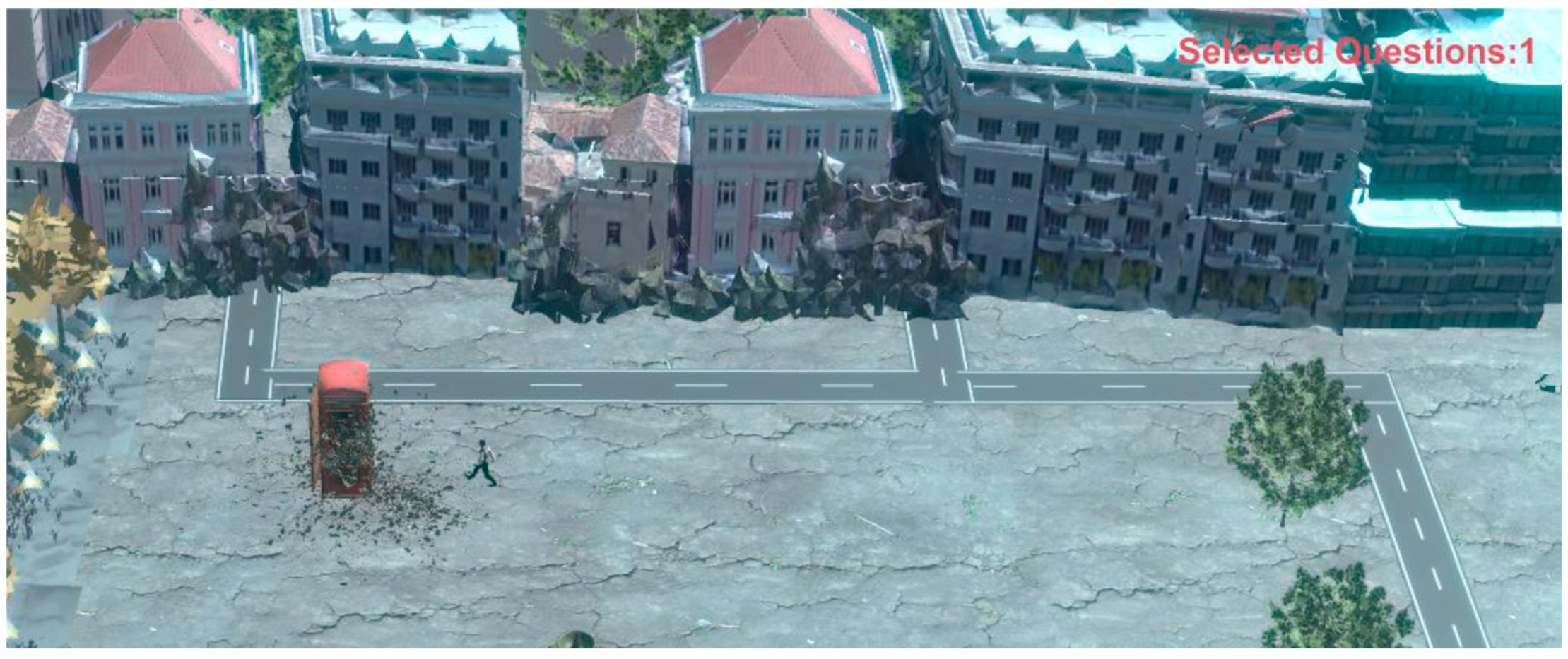

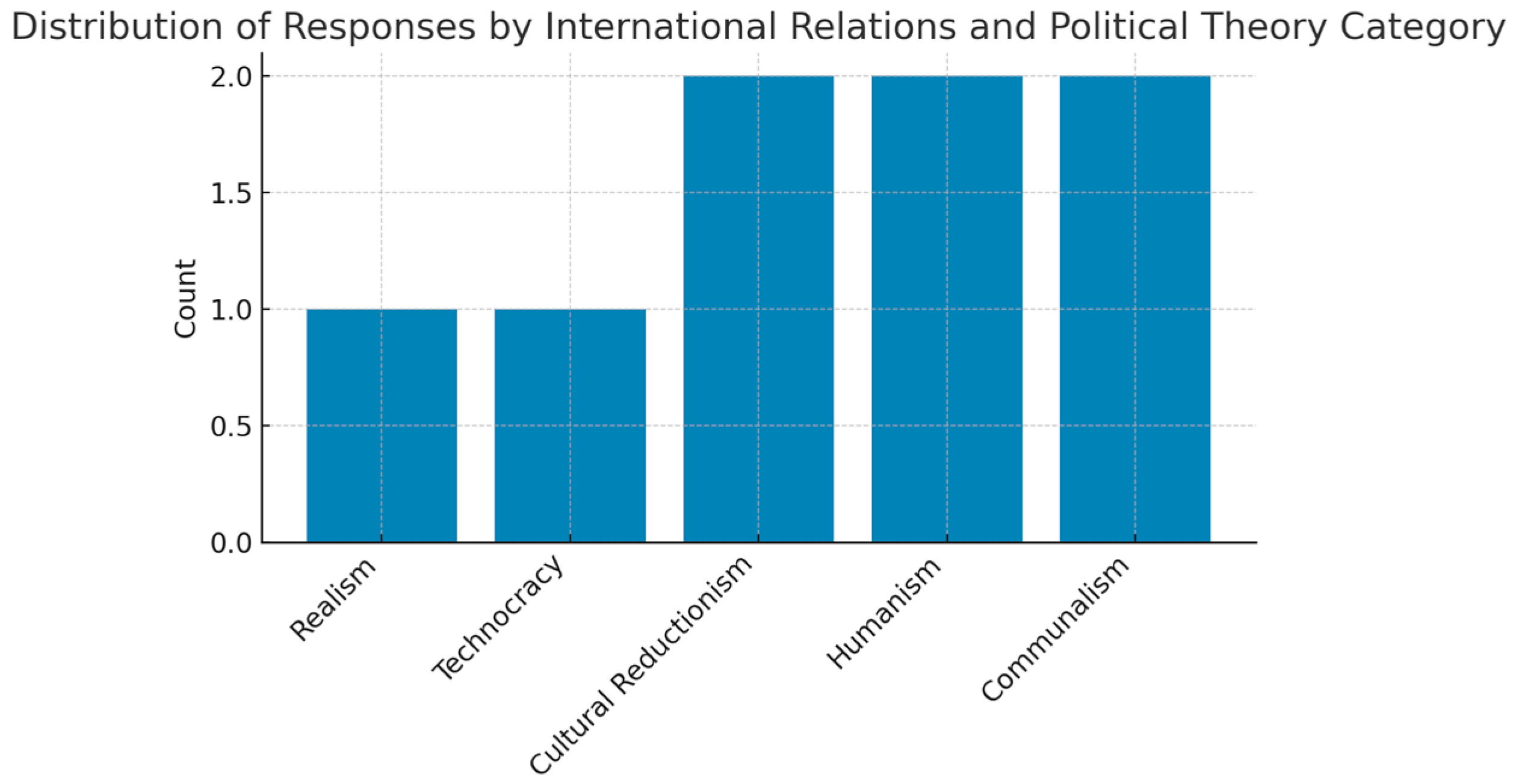

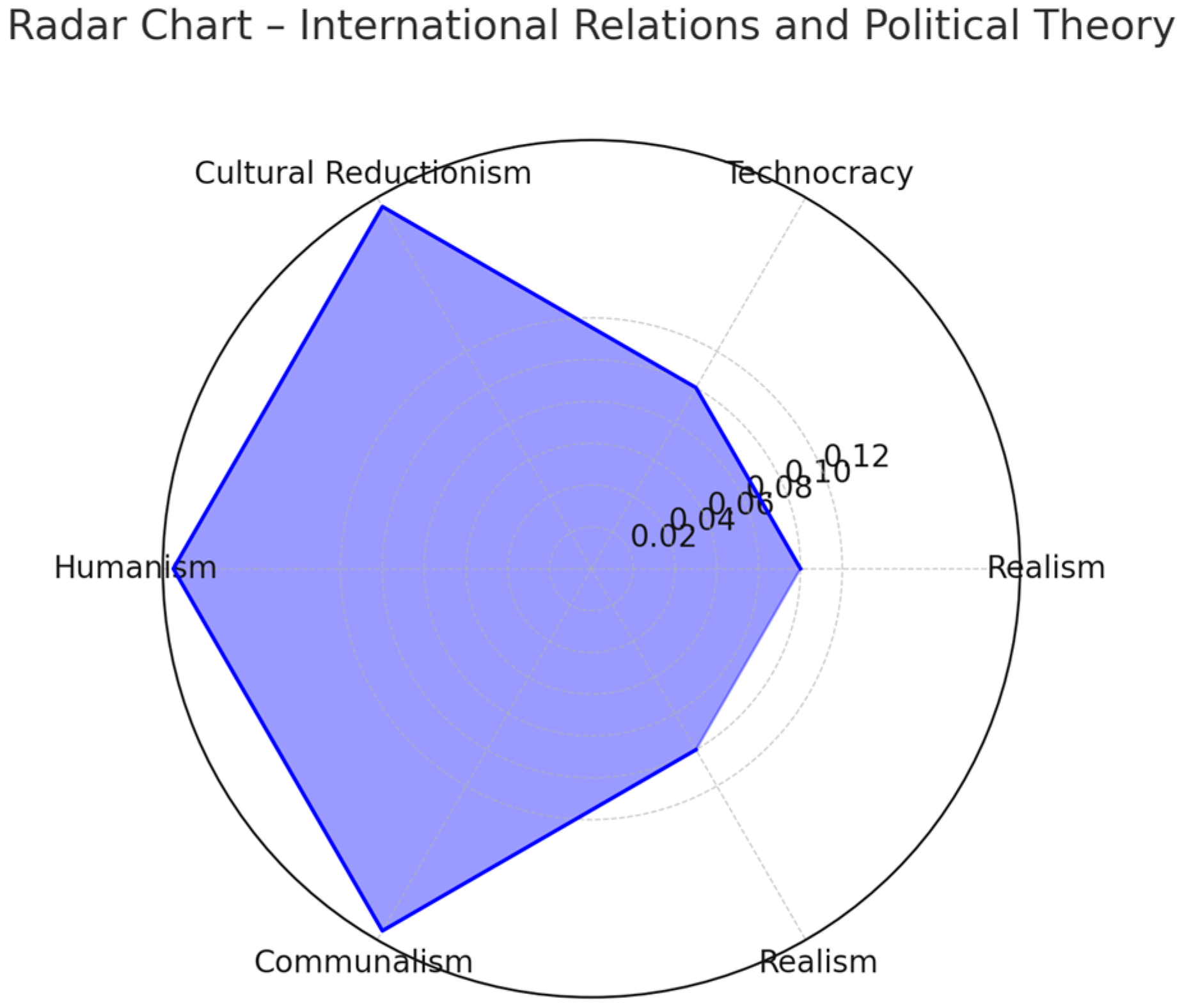





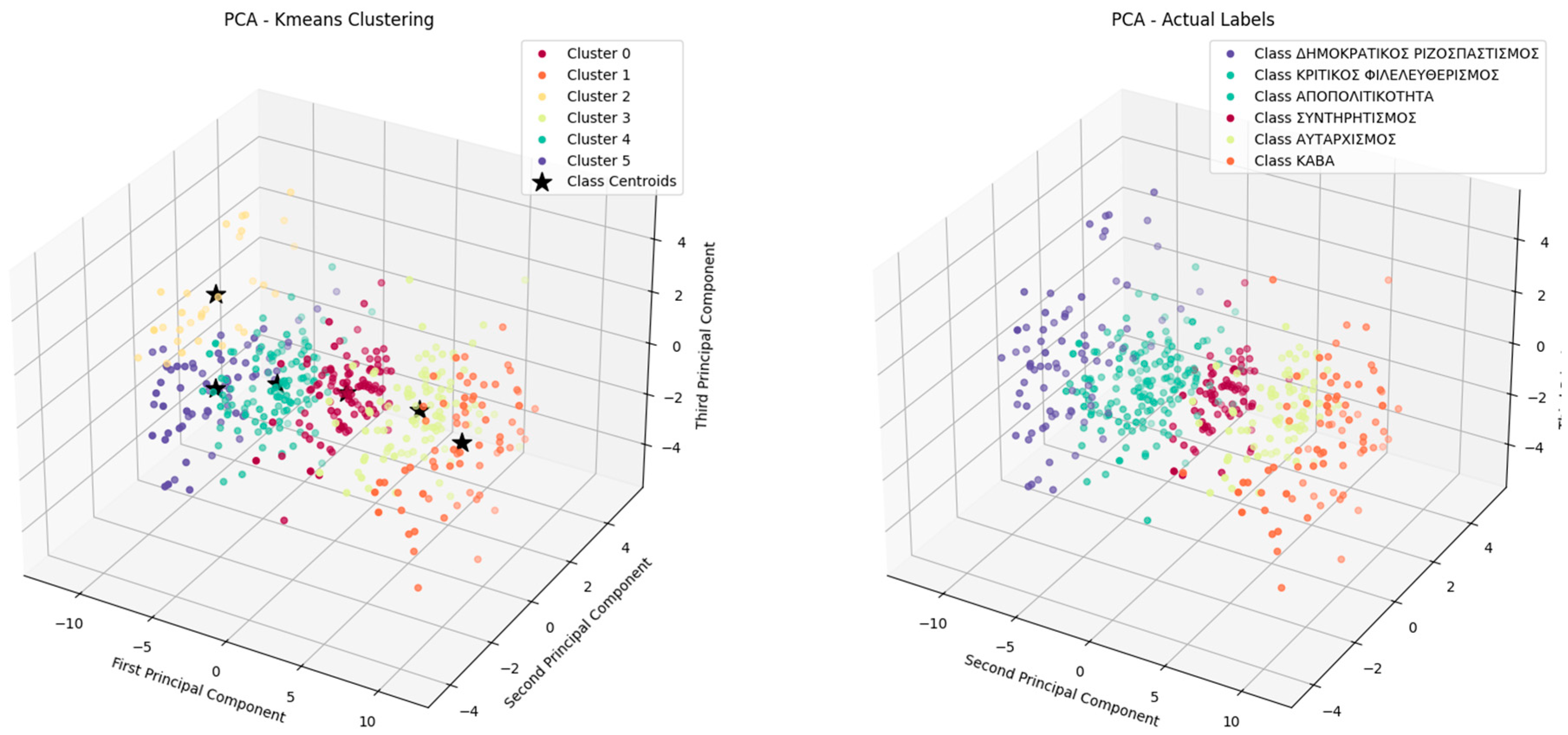


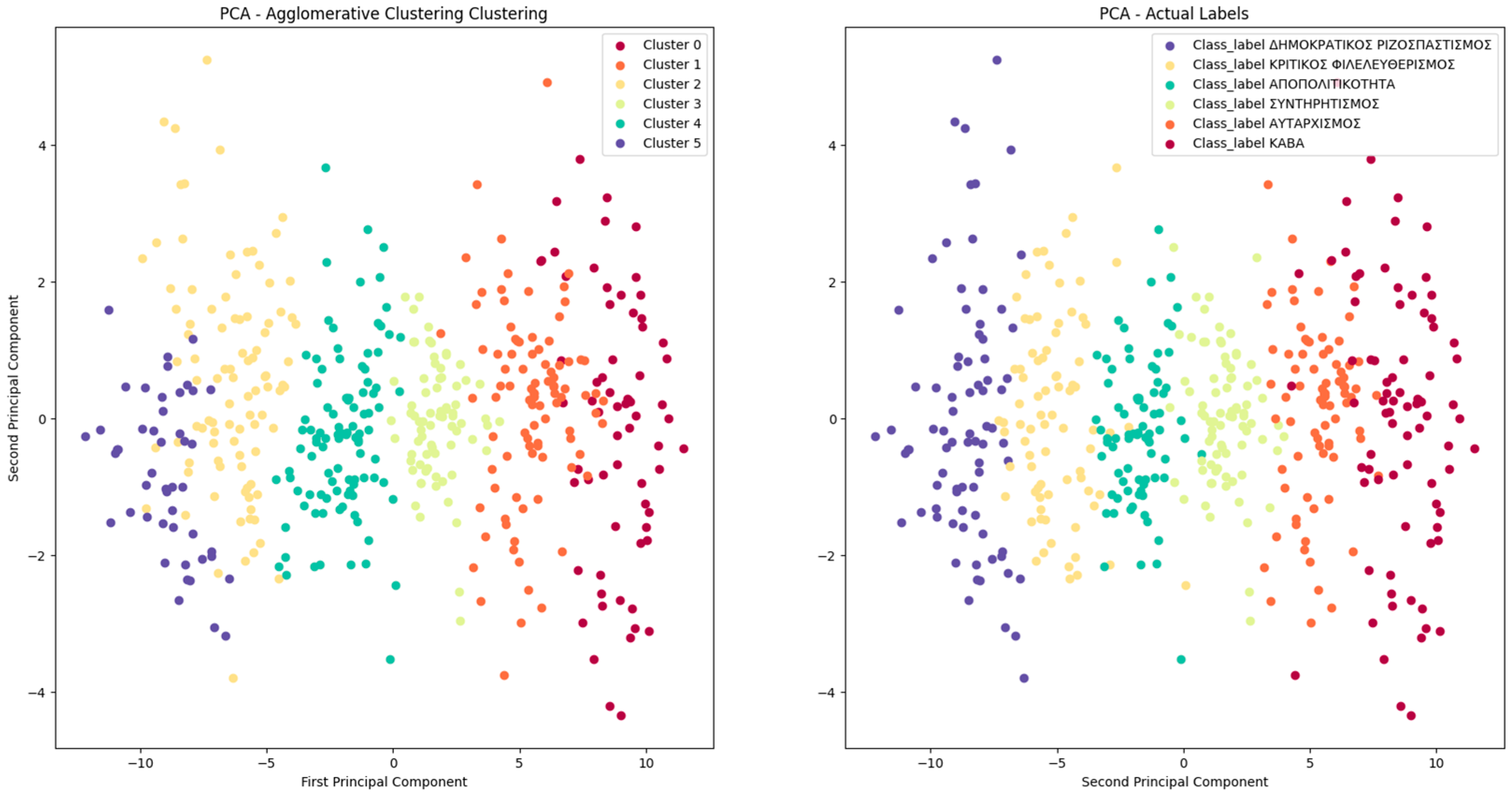
Disclaimer/Publisher’s Note: The statements, opinions and data contained in all publications are solely those of the individual author(s) and contributor(s) and not of MDPI and/or the editor(s). MDPI and/or the editor(s) disclaim responsibility for any injury to people or property resulting from any ideas, methods, instructions or products referred to in the content. |
© 2025 by the authors. Licensee MDPI, Basel, Switzerland. This article is an open access article distributed under the terms and conditions of the Creative Commons Attribution (CC BY) license (https://creativecommons.org/licenses/by/4.0/).
Share and Cite
Gazis, A.; Katsiri, E. Gamifying Sociological Surveys Through Serious Games—A Data Analysis Approach Applied to Multiple-Choice Question Responses Datasets. Computers 2025, 14, 224. https://doi.org/10.3390/computers14060224
Gazis A, Katsiri E. Gamifying Sociological Surveys Through Serious Games—A Data Analysis Approach Applied to Multiple-Choice Question Responses Datasets. Computers. 2025; 14(6):224. https://doi.org/10.3390/computers14060224
Chicago/Turabian StyleGazis, Alexandros, and Eleftheria Katsiri. 2025. "Gamifying Sociological Surveys Through Serious Games—A Data Analysis Approach Applied to Multiple-Choice Question Responses Datasets" Computers 14, no. 6: 224. https://doi.org/10.3390/computers14060224
APA StyleGazis, A., & Katsiri, E. (2025). Gamifying Sociological Surveys Through Serious Games—A Data Analysis Approach Applied to Multiple-Choice Question Responses Datasets. Computers, 14(6), 224. https://doi.org/10.3390/computers14060224






